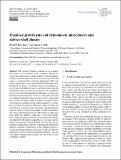Files in this item
Frazil-ice growth rate and dynamics in mixed layers and sub-ice-shelf plumes
Item metadata
| dc.contributor.author | Rees Jones, David W. | |
| dc.contributor.author | Wells, Andrew J. | |
| dc.date.accessioned | 2019-07-03T11:30:09Z | |
| dc.date.available | 2019-07-03T11:30:09Z | |
| dc.date.issued | 2018-01-08 | |
| dc.identifier | 259433704 | |
| dc.identifier | 1045f3f1-8c49-4990-affd-15ec727bd8d5 | |
| dc.identifier | 85040369193 | |
| dc.identifier.citation | Rees Jones , D W & Wells , A J 2018 , ' Frazil-ice growth rate and dynamics in mixed layers and sub-ice-shelf plumes ' , The Cryosphere , vol. 12 , no. 1 , pp. 25-38 . https://doi.org/10.5194/tc-12-25-2018 | en |
| dc.identifier.issn | 1994-0416 | |
| dc.identifier.other | ORCID: /0000-0001-8698-401X/work/59222358 | |
| dc.identifier.uri | https://hdl.handle.net/10023/18032 | |
| dc.description | Funding: David W. Rees Jones acknowledges research funding through the NERC Consortium Grant NE/M000427/1 and NERC Standard Grant NE/I026995/1. We would like to thank the Isaac Newton Institute for Mathematical Sciences for its hospitality during the programme Melt in the Mantle, which was supported by EPSRC grant number EP/K032208/1 | en |
| dc.description.abstract | The growth of frazil or granular ice is an important mode of ice formation in the cryosphere. Recent advances have improved our understanding of the microphysical processes that control the rate of ice-crystal growth when water is cooled beneath its freezing temperature. These advances suggest that crystals grow much faster than previously thought. In this paper, we consider models of a population of ice crystals with different sizes to provide insight into the treatment of frazil ice in large-scale models. We consider the role of crystal growth alongside the other physical processes that determine the dynamics of frazil ice. We apply our model to a simple mixed layer (such as at the surface of the ocean) and to a buoyant plume under a floating ice shelf. We provide numerical calculations and scaling arguments to predict the occurrence of frazil-ice explosions, which we show are controlled by crystal growth, nucleation, and gravitational removal. Faster crystal growth, higher secondary nucleation, and slower gravitational removal make frazil-ice explosions more likely. We identify steady-state crystal size distributions, which are largely insensitive to crystal growth rate but are affected by the relative importance of secondary nucleation to gravitational removal. Finally, we show that the fate of plumes underneath ice shelves is dramatically affected by frazil-ice dynamics. Differences in the parameterization of crystal growth and nucleation give rise to radically different predictions of basal accretion and plume dynamics, and can even impact whether a plume reaches the end of the ice shelf or intrudes at depth. | |
| dc.format.extent | 14 | |
| dc.format.extent | 3083447 | |
| dc.language.iso | eng | |
| dc.relation.ispartof | The Cryosphere | en |
| dc.subject | QC Physics | en |
| dc.subject | QE Geology | en |
| dc.subject | Earth-Surface Processes | en |
| dc.subject | Water Science and Technology | en |
| dc.subject | DAS | en |
| dc.subject | BDC | en |
| dc.subject.lcc | QC | en |
| dc.subject.lcc | QE | en |
| dc.title | Frazil-ice growth rate and dynamics in mixed layers and sub-ice-shelf plumes | en |
| dc.type | Journal article | en |
| dc.contributor.institution | University of St Andrews. Applied Mathematics | en |
| dc.identifier.doi | https://doi.org/10.5194/tc-12-25-2018 | |
| dc.description.status | Peer reviewed | en |
This item appears in the following Collection(s)
Items in the St Andrews Research Repository are protected by copyright, with all rights reserved, unless otherwise indicated.

